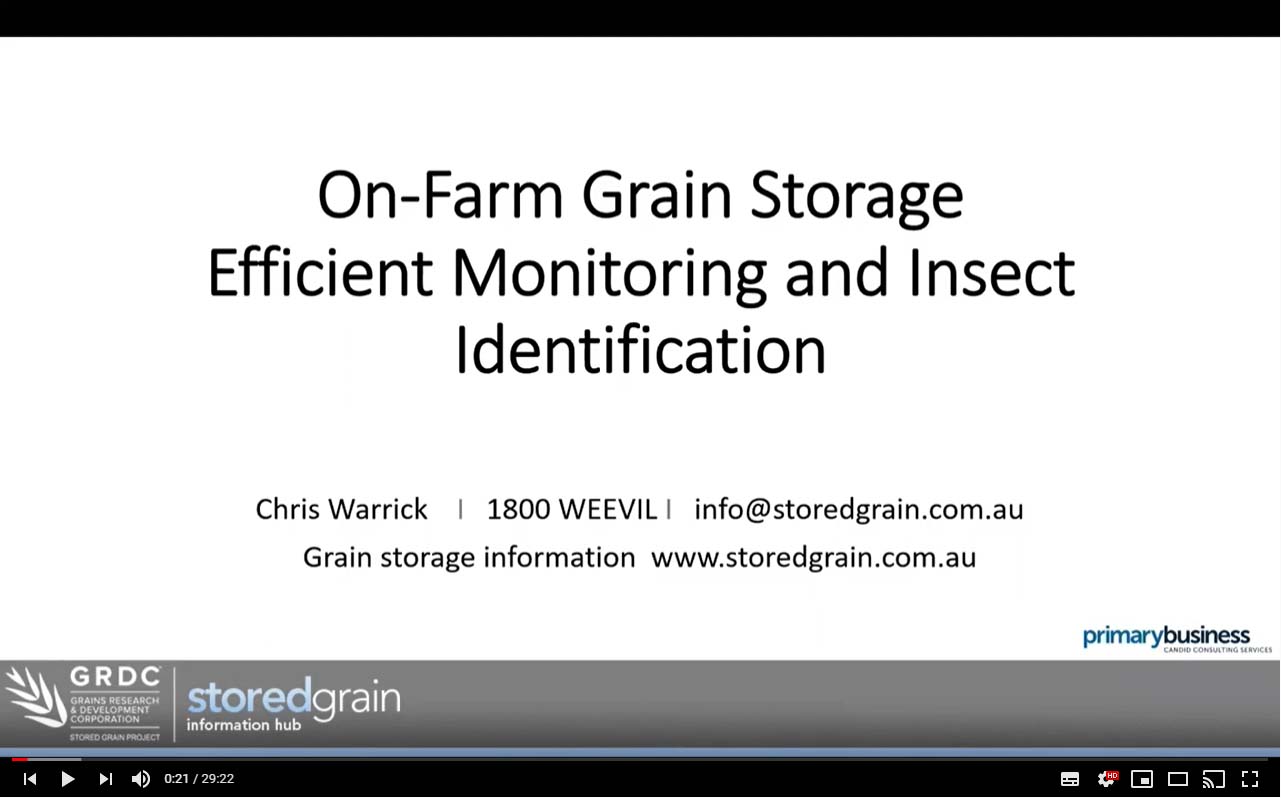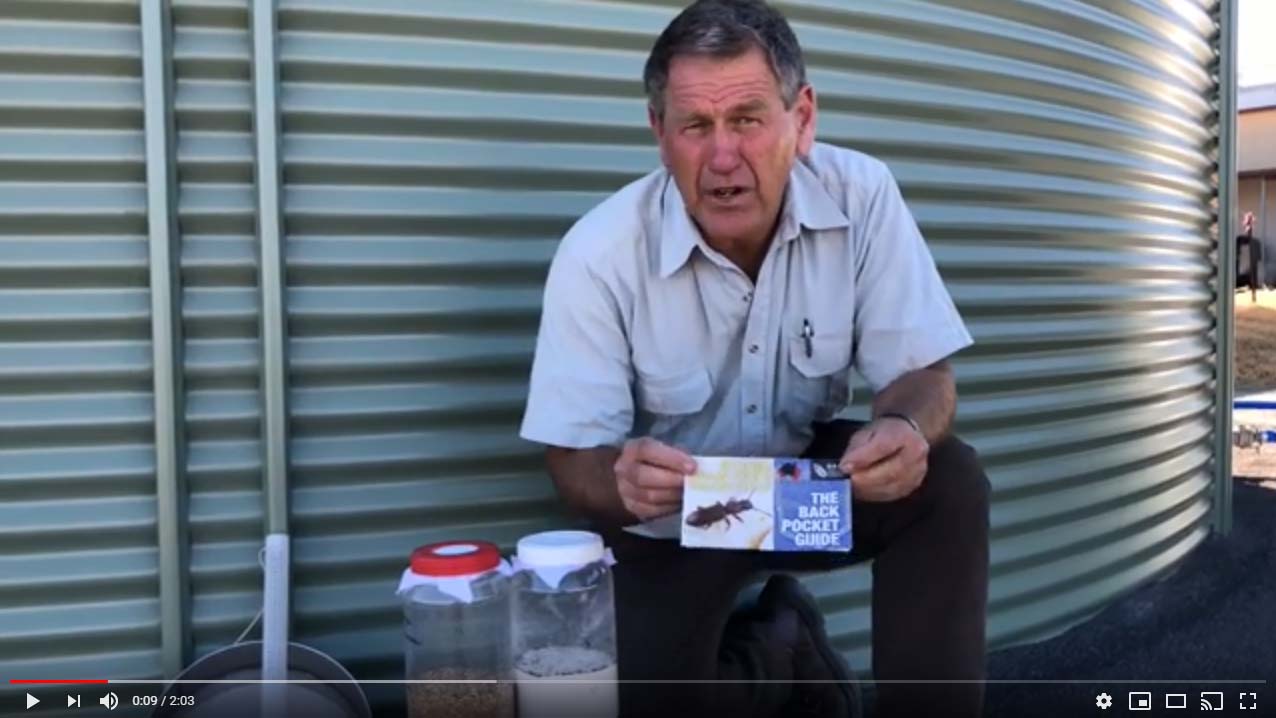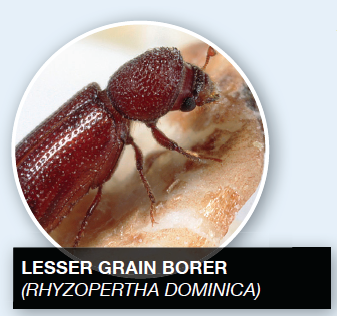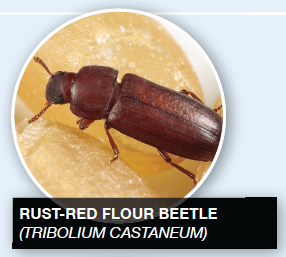Grain storage specialist Chris Warrick presents a webinar on efficient monitoring and insect identification
Continue readingIdentifying pests with the back pocket guide
Philip Burrill provides some tips on identifying grain storage pests using the GRDC Back Pocket Guide to Stored Grain Pests
Identification of the flat grain beetles (Cryptolestes spp.) of Australia – DAF
Three species of flat grain beetles (Cryptolestes spp.) occur in stored grain in Australia. Adults are fast moving, small (2mm), flat, with longer antennae than most stored grain pests. Cryptolestes species occur in all grain growing regions of Australia. One species, the rusty grain beetle, Cryptolestes ferrugineus, has developed a strong resistance to phosphine at a number of sites in eastern Australia. Correct identification of this pest will facilitate appropriate management practices. Following is a guide to the identification of flat grain beetle species in Australia.
Northern & Southern Regions Stored Grain Pests – Identification
In a deregulated grain market, on-farm storage is now more popular then ever before. But finding insects crawling up the sides of your grain hopper while loading a truck is frustrating and costly to manage. Regular monitoring and correct pest identification are the first steps to ensure delivery of insect-free grain to market.
Key Points
- Avoid surprises when selling stored grain by monitoring for insect pests monthly. Correct insect identification will allow for more targeted pest control options. Sample from the top and bottom of grain stores for early pest detection. Warming an insect sieve in the sunlight will encourage insect movement, making pests easier to see. Exotic pests are a threat to the Australian grains industry — report sightings immediately.
Why is identification important?
Being able to identify the most common insect pests of stored grain puts growers well ahead when it comes to making the best control decisions. For example, the lesser grain borer is a serious pest in most regions of Australia, but can now only be reliably controlled with one or two products due to resistance. So if growers intend applying control treatments they need to know which species are present.
Identification of the particular pest present can highlight a future preventative measure. For example, psocids thrive in warm, humid conditions. Using aeration to lower grain temperature and storing grain at a lower moisture content could prevent a future problem from occurring.
With an increasing number of grain markets requesting reduced chemical residues on grain it is becoming more important to better identify and understand pests. In doing so growers can exploit the best use of both chemical and non-chemical control measures. As there are limited tools available to control pests in stored oilseeds and pulses, meticulous hygiene, well-managed aeration and regular monitoring is essential.
Key pest species
Cereal grains include wheat, barley, oats, triticale, sorghum and maize. The most common insect pests of stored cereal grains in Australia are:
- Weevils: (Sitophilus spp.) Rice weevil is the most common weevil found in wheat in Australia
- Lesser grain borer: (Rhyzopertha dominica)
- Rust-red flour beetle: (Tribolium spp.)
- Saw-toothed grain beetle: (Oryzaephilus spp.)
- Flat grain beetle: (Cryptolestes spp.)
- Indian meal moth: (Plodia interpunctella)
- Angoumois grain moth: (Sitotroga cerealella)
Another dozen or so beetles, psocids (booklice) and mites are sometimes present as pests in stored cereal grain.
Oilseeds include canola, linseed, safflower, cottonseed and sunflower.
The most common pests in stored oilseeds are:
- Flour beetles
- Saw-toothed grain beetles
- Moths
Resistance
The lesser grain borer and saw-toothed grain beetle have developed resistance to a number of grain insecticides. Poor fumigation practices (such as unsealed silos) have also increased the number of phosphine-resistant stored grain pests. Such resistance can threaten grain exports, as live insects remain in grain after fumigation. If insects survive fumigation, contact your regional grain storage specialist.
IDENTIFICATION OF COMMON BEETLE PESTS OF STORED GRAIN
 LESSER GRAIN BORER (RHYZOPERTHA DOMINICA)
LESSER GRAIN BORER (RHYZOPERTHA DOMINICA)
- A serious pest of most stored grains.
- Dark brown cylindrical beetle (3mm long). Borers have their head tucked under their body with their eyes and mouth only visible from the side.
- Adult beetles are strong flyers and live for 2–3 months.
- Females lay 200–400 eggs on grain surface. Breeding ceases below 18°C.
- Young larvae (white with brown heads) initially feed outside then bore into grain.
- Life cycle completed in four weeks at 35°C and seven weeks at 22°C.
- Aeration cooling effectively reduces activity and breeding.
- Their habit is to remain hidden in grain. Sieving required for detection.
 RUST-RED FLOUR BEETLE (TRIBOLIUM CASTANEUM)
RUST-RED FLOUR BEETLE (TRIBOLIUM CASTANEUM)
- Common pest of stored cereal grain, processed grain products, oilseeds, nuts and dried fruit.
- Adult beetles are reddish-brown (3–4.5mm long) with club-shaped segments on antennae ends.
- Adults live from 200 days to two years and fly in warm conditions.
- Beetles will infest grain, but breed more successfully on processed products (such as flour).
- Up to 1000 eggs per female, loosely scattered through the commodity.
- Cream-coloured larvae feed externally on damaged grain and cereal dust.
- Life cycle completed in four weeks at 30°C, 11 weeks at 22°C and reproduction stops below 20°C.
- Similar species: Tribolium confusum — confused flour beetle, more common in cool, temperate regions.
 RICE WEEVIL (SITOPHILUS ORYZAE)
RICE WEEVIL (SITOPHILUS ORYZAE)
- Major pest of whole cereal grains.
- Small (3–4mm long ) dark brown-black weevil with a long ‘snout’ and four light spots on back.
- Adults live 2–3 months, do not readily fly but climb vertical surfaces (for example, glass jar).
- White larvae generally not seen as they feed and develop inside single grains.
- Life cycle completed in four weeks at 30°C, 15 weeks at 18°C, breeding stops below 15°C.
- Similar species: Sitophilus zeamais – maize weevil, and Sitophilus granarius – granary weevil.
 SAW-TOOTHED GRAIN BEETLE (ORYZAEPHILUS SURINAMENSIS)
SAW-TOOTHED GRAIN BEETLE (ORYZAEPHILUS SURINAMENSIS)
- Infests cereal grains, oilseeds, processed products, peanuts and dried fruits.
- Fast moving, dark brown-black beetle (3mm long) with characteristic saw-toothed pattern on each side of thorax.
- Adults move rapidly through stored grain and fly in warm conditions. They may live for several months.
- Females lay 300–400 eggs loosely throughout the grain stack. ´ White, flattened larvae feed and develop externally but are hard to see.
- Preference for damaged or processed grain to establish in significant numbers.
- Life cycle completed in three weeks at 30–33°C, 17 weeks at 20°C, reproduction stops below 17.5°C.
 FLAT GRAIN BEETLE (CRYPTOLESTES SPP.)
FLAT GRAIN BEETLE (CRYPTOLESTES SPP.)
- Infests most stored grain feeding on damaged grain.
- Small, flat and fast moving reddish-brown beetles (2mm long) with long antennae.
- Adults fly readily and can live for several months.
- Females lay up to 300 eggs loosely in the grain stack.
- Larvae, with characteristic tail and horns, feed and develop externally on damaged grains.
- Life cycle completed in four weeks at 30–35°C with moist conditions, 13 weeks at 20°C, breeding stops at 17.5°C.
- There are several closely related Cryptolestes species with similar appearance and habits.
- A strain of flat grain beetle has developed high phosphine resistance. Contact your regional grain storage specialist.
 PSOCIDS (LIPOSCELIS SPP.), BOOKLICE
PSOCIDS (LIPOSCELIS SPP.), BOOKLICE
- Infests a wide range of grains and commodities.
- Considered a secondary pest, feeding on damaged grain and moulds.
- Very small (1mm long) usually, appears as a ‘moving carpet of dust’ on grain or storage structures.
- Eggs laid on grain surface, hatching to nymphs that moult through to adult stage.
- Thrives under warm, moist conditions – optimum 25°C and 75% relative humidity. Life cycle 21 days.
- Three main species of psocids in Australia, often in mixed populations. Some can fly.
EXOTIC PESTS – BE ON THE LOOKOUT
The following pests have a high potential impact on the value of stored grain if they were to establish in Australia. Report any unusual sightings immediately to the local State department of agriculture or ring the Exotic Plant Pest Hotline on 1800 084 881.
 KARNAL BUNT (TILLETIA INDICA)
KARNAL BUNT (TILLETIA INDICA)
- Not present in Australia. ´
- Can infect wheat, durum and triticale.
- ´ Usually only part of each grain is affected.
- ´ Infected stored grain will have a sooty appearance and will crush easily, leaving a black powder.
- ´ Infected grain often has a rotten fish smell, flour quality is seriously reduced.
- ´ Symptoms are similar to common bunt.
 KHAPRA BEETLE (TROGODERMA GRANARIUM)
KHAPRA BEETLE (TROGODERMA GRANARIUM)
- Not present in Australia.
- Attacks most stored grains.
- Adults have wings but do not fly.
- Larvae are covered in fine hairs.
- Looks identical to the warehouse beetle to the naked eye.
- Causes grain loss in storage.
- Larvae skins contaminate grain and cause allergies on consumption.
- Phosphine fumigation is not reliably effective.
Monitoring information
 To maintain grain quality and to select the correct treatments, identify pests early by sampling monthly.
To maintain grain quality and to select the correct treatments, identify pests early by sampling monthly.
Sieving is the most effective method of detecting grain pests. Sieve samples from the top and bottom of stores to detect low levels of insects early. Sieving samples onto a white tray will make it easier to see small insects.
Holding the tray in the sunlight warms the insects and encourages movement making it easier to identify them and monitor population numbers.
Grain pest identification
 A clean glass container helps to identify grain pests. Place the live insects into a warm glass container (above 20°C so they are active, but not hot or they will die).
A clean glass container helps to identify grain pests. Place the live insects into a warm glass container (above 20°C so they are active, but not hot or they will die).
Weevils and saw-toothed grain beetles can walk up the walls of the glass easily, but flour beetles and lesser grain borer cannot. Look closely at the insects walking up the glass — weevils have a curved snout at the front but saw-toothed grain beetles do not.
Western Region – Stored Grain Pests – Identification
In a deregulated grain market, on-farm storage is now more popular then ever before. But finding insects crawling up the sides of your grain hopper while loading a truck is frustrating and costly to manage. Regular monitoring is the first step to ensure delivery of insect-free grain to market.
Key Points
- Avoid surprises when selling stored grain by monitoring for insect pests monthly.
- Sample from the top and bottom of grain stores for early pest detection.
- Warming an insect sieve in the sunlight will encourage insect movement, making pests easier to see.
- Correct insect identification will allow for more targeted pest control options.
- Exotic pests are a threat to the Australian grains industry — report sightings immediately.
Insect control protects grain
If stored grain is not properly managed there is a potential for it to become infested with stored grain pests. Grain for domestic human consumption and especially grain for export must not contain live insects. Regular inspection by sieving grain from the top and bottom of silos will provide an early warning of insect infestation. Pitfall traps installed in the top of the grain store will show insects are active long before they are seen on the surface of the grain. Protecting any grain stored from insect attack makes economic sense, because even feed grain can lose value though loss of protein or palatability, affecting livestock growth rates. Seed grain is next year’s investment and if boring insects are present they will destroy the germ of the grain. Key pest species Cereal grains include wheat, barley, oats, triticale, sorghum and maize.
The most common insect pests of stored cereal grains in Australia are:
- Weevils: (Sitophilus spp.) Rice weevil is the most common weevil in wheat in Australia
- Lesser grain borer: (Rhyzopertha dominica)
- Rust-red flour beetle: (Tribolium spp.)
- Saw-toothed grain beetle: (Oryzaephilus spp.)
- Flat grain beetle: (Cryptolestes spp.)
- Indian meal moth: (Plodia interpunctella)
- Angoumois grain moth: (Sitotroga cerealella)
Another dozen or so beetles, psocids (booklice) and mites are sometimes present as pests in stored cereal grain. Oilseeds include canola, linseed, safflower, cottonseed and sunflower. The most common pests in stored oilseeds are:
- Flour beetles
- Saw-toothed grain beetles
- Moths
Resistance
Poor fumigation practices (such as unsealed silos) have also increased the number of phosphine-resistant stored grain pests. Such resistance can threaten grain exports as live insects remain in grain after fumigation. If insects survive fumigation, contact your regional grain storage specialist.
IDENTIFICATION OF COMMON BEETLE PESTS OF STORED GRAIN
 LESSER GRAIN BORER (RHYZOPERTHA DOMINICA)
LESSER GRAIN BORER (RHYZOPERTHA DOMINICA)
- A serious pest of most stored grains.
- Dark brown cylindrical beetle (3mm long). Borers have their head tucked under their body with their eyes and mouth only visible from the side.
- Adult beetles are strong flyers and live for 2–3 months.
- Females lay 200–400 eggs on grain surface. Breeding ceases below 18°C.
- Young larvae (white with brown heads) initially feed outside then bore into grain.
- Life cycle completed in four weeks at 35°C and seven weeks at 22°C.
- Aeration cooling effectively reduces activity and breeding.
- Their habit is to remain hidden in grain. Sieving required for detection.
 RUST-RED FLOUR BEETLE (TRIBOLIUM CASTANEUM)
RUST-RED FLOUR BEETLE (TRIBOLIUM CASTANEUM)
- Common pest of stored cereal grain, processed grain products, oilseeds, nuts and dried fruit.
- Adult beetles are reddish-brown (3–4.5mm long) with club-shaped segments on antennae ends.
- Adults live from 200 days to two years and fly in warm conditions.
- Beetles will infest grain, but breed more successfully on processed products (such as flour).
- Up to 1000 eggs per female, loosely scattered through the commodity.
- Cream-coloured larvae feed externally on damaged grain and cereal dust.
- Life cycle completed in four weeks at 30°C, 11 weeks at 22°C and reproduction stops below 20°C.
- Similar species: Tribolium confusum — confused flour beetle, more common in cool, temperate regions.
 RICE WEEVIL (SITOPHILUS ORYZAE)
RICE WEEVIL (SITOPHILUS ORYZAE)
- Major pest of whole cereal grains.
- Small (3–4mm long ) dark brown-black weevil with a long ‘snout’ and four light spots on back.
- Adults live 2–3 months, do not readily fly but climb vertical surfaces (for example, glass jar).
- White larvae generally not seen as they feed and develop inside single grains.
- Life cycle completed in four weeks at 30°C, 15 weeks at 18°C, breeding stops below 15°C.
- Similar species: Sitophilus zeamais – maize weevil, and Sitophilus granarius – granary weevil.
 SAW-TOOTHED GRAIN BEETLE (ORYZAEPHILUS SURINAMENSIS)
SAW-TOOTHED GRAIN BEETLE (ORYZAEPHILUS SURINAMENSIS)
- Infests cereal grains, oilseeds, processed products, peanuts and dried fruits.
- Fast moving, dark brown-black beetle (3mm long) with characteristic saw-toothed pattern on each side of thorax.
- Adults move rapidly through stored grain and fly in warm conditions. They may live for several months.
- Females lay 300–400 eggs loosely throughout the grain stack. ´ White, flattened larvae feed and develop externally but are hard to see.
- Preference for damaged or processed grain to establish in significant numbers.
- Life cycle completed in three weeks at 30–33°C, 17 weeks at 20°C, reproduction stops below 17.5°C.
 FLAT GRAIN BEETLE (CRYPTOLESTES SPP.)
FLAT GRAIN BEETLE (CRYPTOLESTES SPP.)
- Infests most stored grain feeding on damaged grain.
- Small, flat and fast moving reddish-brown beetles (2mm long) with long antennae.
- Adults fly readily and can live for several months.
- Females lay up to 300 eggs loosely in the grain stack.
- Larvae, with characteristic tail and horns, feed and develop externally on damaged grains.
- Life cycle completed in four weeks at 30–35°C with moist conditions, 13 weeks at 20°C, breeding stops at 17.5°C.
- There are several closely related Cryptolestes species with similar appearance and habits.
- A strain of flat grain beetle has developed high phosphine resistance. Contact your regional grain storage specialist.
 PSOCIDS (LIPOSCELIS SPP.), BOOKLICE
PSOCIDS (LIPOSCELIS SPP.), BOOKLICE
- Infests a wide range of grains and commodities.
- Considered a secondary pest, feeding on damaged grain and moulds.
- Very small (1mm long) usually, appears as a ‘moving carpet of dust’ on grain or storage structures.
- Eggs laid on grain surface, hatching to nymphs that moult through to adult stage.
- Thrives under warm, moist conditions – optimum 25°C and 75% relative humidity. Life cycle 21 days.
- Three main species of psocids in Australia, often in mixed populations. Some can fly.
EXOTIC PESTS – BE ON THE LOOKOUT
The following pests have a high potential impact on the value of stored grain if they were to establish in Australia. Report any unusual sightings immediately to the local State department of agriculture or ring the Exotic Plant Pest Hotline on 1800 084 881.
 KARNAL BUNT (TILLETIA INDICA)
KARNAL BUNT (TILLETIA INDICA)
- Not present in Australia. ´
- Can infect wheat, durum and triticale.
- ´ Usually only part of each grain is affected.
- ´ Infected stored grain will have a sooty appearance and will crush easily, leaving a black powder.
- ´ Infected grain often has a rotten fish smell, flour quality is seriously reduced.
- ´ Symptoms are similar to common bunt.
 KHAPRA BEETLE (TROGODERMA GRANARIUM)
KHAPRA BEETLE (TROGODERMA GRANARIUM)
- Not present in Australia.
- Attacks most stored grains.
- Adults have wings but do not fly.
- Larvae are covered in fine hairs.
- Looks identical to the warehouse beetle to the naked eye.
- Causes grain loss in storage.
- Larvae skins contaminate grain and cause allergies on consumption.
- Phosphine fumigation is not reliably effective.
Monitoring information
 To maintain grain quality and to select the correct treatments, identify pests early by sampling monthly.
To maintain grain quality and to select the correct treatments, identify pests early by sampling monthly.
Sieving is the most effective method of detecting grain pests. Sieve samples from the top and bottom of stores to detect low levels of insects early. Sieving samples onto a white tray will make it easier to see small insects.
Holding the tray in the sunlight warms the insects and encourages movement making it easier to identify them and monitor population numbers.
Grain pest identification
 A clean glass container helps to identify grain pests. Place the live insects into a warm glass container (above 20°C so they are active, but not hot or they will die).
A clean glass container helps to identify grain pests. Place the live insects into a warm glass container (above 20°C so they are active, but not hot or they will die).
Weevils and saw-toothed grain beetles can walk up the walls of the glass easily, but flour beetles and lesser grain borer cannot. Look closely at the insects walking up the glass — weevils have a curved snout at the front but saw-toothed grain beetles do not.





